Development and Quality Characteristics of Elderly-Friendly Pulpo a La Gallega Prepared Using Texture-Modified Octopus (Octopus vulgaris) Arms
Abstract
1. Introduction
2. Materials and Methods
2.1. Materials
2.2. Manufacture of Octopus Pulpo a La Gallega Prototypes
2.3. Establishment of Octopus Sous Vide Conditions by Response Surface Methodology (RSM)
2.4. Hardness
2.5. Total Acidity Analysis
2.6. Volatile Basic Nitrogen (VBN) Analysis
2.7. Total Bacterial Count (TBC) Analysis
2.8. Determination of Proximate Components (Moisture, Protein, Fat, Ash, and Carbohydrates) and Calories
2.9. Salinity Analysis
2.10. Total Amino Acid Analysis
2.11. Fatty Acid Analysis
2.12. Mineral Analysis
2.13. Analysis of Lead and Cadmium
2.14. Sensory Texture for Optimizing the Manufacturing Conditions of the Octopus Pulpo a La Gallega
2.15. Preference Evaluation of Prototypes
2.16. Scanning Electron Microscope (SEM)
2.17. Statistical Analysis
3. Results
3.1. Effects of Sous Vide and Vinegar Treatment Conditions on Octopus Arm Hardness
3.2. Effects of Sous Vide Treatment and Vinegar Immersion Conditions on the Total Acidity of Octopus Arms
3.3. Effects of the Sous Vide Treatment and Vinegar Immersion Conditions on the Sensory Texture of Octopus Arms
3.4. Optimization of Vinegar Immersion and Sous Vide Softening Treatment Conditions for Raw Octopus Arms
3.5. Proximate Composition, Energy, and Salinity
3.6. Total Amino Acid Content
3.7. Mineral Content
3.8. Fatty Acid Contents
3.9. pH and Volatile Basic Nitrogen (VBN)
3.10. Total Bacterial Counts (TBC)
3.11. Heavy Metal Contents
3.12. Scanning Electron Microscopy (SEM) Observations
3.13. Acceptability Evaluation of Prototypes
4. Discussion
5. Conclusions
Supplementary Materials
Author Contributions
Funding
Institutional Review Board Statement
Data Availability Statement
Conflicts of Interest
References
- KOSIS (Korean Statistical Information Service). Fisheries Statistics. 2022. Available online: http://kosis.kr/statisticsList/statisticsListIndex.do?menuId=M_01_01&vwcd=MT_ZTITLE&parmTabId=M_01_01#SelectStatsBoxDiv (accessed on 5 May 2021).
- Lapid, M.-I.; Prom, M.-C.; Burton, M.-C.; McAlpine, D.-E.; Sutor, B.; Rummans, T.-A. Eating disorders in the elderly. Syst. Rev. 2010, 4, 523–536. [Google Scholar] [CrossRef]
- Mulchandani, M.; Shetty, M.; Conrad, A.; Muir, P.; Mah, B. Treatment of eating disorders in older people: A systematic review. Int. Psychogeriatr. 2021, 10, 1–20. [Google Scholar] [CrossRef]
- MFDS (Ministry of Food and Drug Safety). Food Code. 2022. Available online: https://www.foodsafetykorea.go.kr/portal/safefoodlife/food/foodRvlv/foodRvlv.do (accessed on 28 December 2022).
- KATS (Korean Agency for Technology and Standards). KS H 4897. 2022. Available online: https://e-ks.kr/streamdocs/view/sd;streamdocsId=72059266244324993 (accessed on 28 December 2022).
- Bhat, Z.-F.; Morton, J.-D.; Bekhit, A.E.D.A.; Kumar, S.; Bhat, H.-F. Emerging processing technologies for improved digestibility of muscle proteins. Trend Food Sci. Technol. 2021, 110, 226–239. [Google Scholar] [CrossRef]
- Chen, X.; Kuhn, E.; Wang, W.; Park, S.; Flanegan, K.; Trass, O.; Tenlep, L.; Tao, L.; Tucker, M. Comparison of different mechanical refining technologies on the enzymatic digestibility of low severity acid pretreated corn stover. Bioresour. Technol. 2013, 147, 401–408. [Google Scholar] [CrossRef] [PubMed]
- Creed, P.G.; Reeve, W. Principles and applications of sous vide processed foods. In Sous Vide and Cook-Chill Processing for the Food Industry; Aspen Publishers Inc.: Gaithersburg, MD, USA, 1998; pp. 25–26. [Google Scholar]
- Mori, M.; Verma, S.K.; Suyani, N.K.; Pal, M. An overview of sous vide technique for seafood processing. Agric. Environ. 2021, 2, 43–47. [Google Scholar]
- Erdem, N.; Karakaya, M.; Babaoğlu, A.S.; Unal, K. Effects of sous vide cooking on physicochemical, structural, and microbiological characteristics of cuttlefish, octopus, and squid. J. Aquatic. Food Prod. 2022, 31, 636–648. [Google Scholar] [CrossRef]
- Schmidt, C.V.; Plankensteinerm, L.; Faxholm, P.L.; Olsen, K.; Mouritsen, O.G.; Frost, M.B. Physicochemical characterization of sous vide cooked squid (Loligo forbesii and Loligo vulgaris) and the relationship to selected sensory properties and hedonic response. Int. J. Gastron. Food Sci. 2021, 23, 100298. [Google Scholar] [CrossRef]
- Bryikle, M.; Akoğlu, A.; Kurhan, S.; Akoğlu, I.T. Effect of different Sous Vide cooking temperature-time combinations on the physicochemical, microbiological, and sensory properties of turkey cutlet. Int. J. Gastron. Food Sci. 2020, 20, 100204. [Google Scholar]
- Modzelewska-Kapituła, M.; Pietrzak-Fiećko, R.; Tkacz, K.; Draszanowska, A.; Więk, A. Influence of sous vide and steam cooking on mineral contents, fatty acid composition and tenderness of semimembranosus muscle from Holstein-Friesian bulls. Meat Sci. 2019, 157, 107877. [Google Scholar] [CrossRef]
- Tirtawijaya, G.; Kim, S.R.; Cho, W.H.; Sohn, J.H.; Kim, J.-S.; Choi, J.-S. Development of a home meal replacement product containing braised mackerel (Scomber japonicus) with radish (Raphanus sativus). Foods 2021, 10, 1135. [Google Scholar] [CrossRef]
- Oh, C.R.; No, J.-K.; Kim, H.-S. Dietary pattern classifications with nutrient intake and body composition changes in Korean elderly. Nutr. Res. Pract. 2014, 8, 192–197. [Google Scholar] [CrossRef]
- Choe, J.Y.; Cho, M.S. Food neophobia and willingness to try non-traditional foods for Koreans. Food Qual. Prefer. 2011, 22, 671–677. [Google Scholar]
- Sert, A.N. Italian cuisine: Characteristics and effects. J. Bus. Manag. Econ. Res. 2017, 1, 49–57. [Google Scholar] [CrossRef]
- Sampaio, I.S. El pulpo a la gallega, un menu tradicional galician octopus, a traditional menu. Revista Tog. 2012, 9, 1–5. [Google Scholar]
- Negara, B.F.S.P.; Gong, H.J.; Lee, M.J.; Choi, J.S. Effect of steam and smoke cooking processes on web-foot Octopus (Amphioctopus sp.) home meal replacement product. Foods 2021, 10, 2825. [Google Scholar] [CrossRef]
- Sutikno, L.A.; Bashir, K.M.I.; Kim, H.; Park, Y.; Won, N.E.; An, J.H.; Jeon, J.H.; Yoon, S.J.; Park, S.M.; Sohn, J.H.; et al. Improvement in physicochemical, microbial, and sensory properties of common squid (Todarodes pacificus Steenstrup) by superheated steam roasting in combination with smoking treatment. J. Food Qual. 2019, 2019, 1–16. [Google Scholar] [CrossRef]
- Vanderzant, C.; Splittstoesser, D.F. Compendium of Methods for the Microbiological Examination of Foods, 3rd ed.; American Health Association: Chicago, IL, USA, 1992; p. 150. [Google Scholar]
- Conway, E.J. Microdiffusion Analysis and Volu-Mertic Error, 3rd ed.; Crosby Lockwood and Son: London, UK, 1950. [Google Scholar]
- AOAC (Association of Official Analytical Chemists). International Official Methods of Analysis Official Methods 990.12, 18th ed.; Association of Official Analytical Chemists: Arlington, VA, USA, 2002. [Google Scholar]
- RDA (Rural Development Administration). 7th Version Food Composition Table I; Hyoil Publishing Co.: Seoul, Republic of Korea, 2007; pp. 7–9. [Google Scholar]
- Bligh, E.G.; Dyer, W.J. A rapid method of lipid extraction and purification. Can. J. Biochem. Physiol. 1959, 37, 911–917. [Google Scholar] [CrossRef]
- Moon, S.K.; Park, H.J.; Jeong, B.Y.; Kim, I.S. The proximate and fatty acid compositions of the liver and gonads of commercial common squid Todarodes pacificus. Korean J. Fish. Aquat. Sci. 2018, 51, 656–666. [Google Scholar] [CrossRef][Green Version]
- Lawless, H.T.; Heymann, H. Sensory Evaluation of Food: Principles and Practices; Springer: New York, NY, USA, 2010; p. 2. [Google Scholar]
- Rattanasatheirn, N.; Benjakul, S.; Visessanguan, W.; Kijroongrojana, K. Properties, translucence, and microstructure of Pacific white shrimp treated with mixed phosphates as affected by freshness and deveining. J. Food Sci. 2008, 73, 31–40. [Google Scholar] [CrossRef]
- Zhou, P.; Regenstein, J.M. Optimization of extraction conditions for pollock skin gelatin. J. Food Sci. 2004, 69, 393–398. [Google Scholar] [CrossRef]
- Isa, K.M.; Daud, S.; Hamidin, N.; Ismail, K.; Saad, S.A.; Kasim, F.H. Thermogravimetric analysis and the optimization of bio-oil yield from fixed-bed pyrolysis of rice husk using response surface methodology (RSM). Ind. Crops Prod. 2011, 33, 481–487. [Google Scholar] [CrossRef]
- Shin, E.C.; Kwak, D.Y.; Ahn, S.Y.; Kwon, S.O.; Choi, Y.J.; Kim, D.M.; Choi, G.B.; Boo, C.G.; Kim, S.B.; Kim, J.S.; et al. Optimization of extrusion cooking conditions for the preparation of seasoning from Manila clam Ruditapes philippinarum. Korean J. Fish. Aquat. Sci. 2020, 53, 823–833. [Google Scholar] [CrossRef]
- Rinaldi, M.; Dall Asta, C.; Paciulli, M.; Cirlini, M.; Manzi, C.; Chiavaro, E. A novel time/temperature approach to sous vide cooking of beef muscle. Food Bioproc. Technol. 2014, 7, 2969–2977. [Google Scholar] [CrossRef]
- Roldán, M.; Antequera, T.; Hernández, A.; Ruiz, J. Physicochemical and microbiological changes during the refrigerated storage of lamb loins sous-vide cooked at different combinations of time and temperature. Food Sci. Technol. Int. 2015, 21, 512–522. [Google Scholar] [CrossRef] [PubMed]
- Kim, J.S.; Kang, S.I. Fisheries Processing for Hands-On Workers; Soohaksa Co.: Seoul, Republic of Korea, 2021; pp. 18–606. [Google Scholar]
- NIFS (National Institute of Fisheries Science). Composition Table of Marine Products in Korea 2018, 8th ed.; National Institute of Fisheries Science: Busan, Republic of Korea, 2018; pp. 128–129.
- MOHW (Ministry of Health and Welfare). Dietary Reference Intakes for Koreans; The Korean Nutrition Society: Sejong, Republic of Korea, 2020; pp. 4–5, 19–20. [Google Scholar]
- Sieiroa, M.P.; Aubourgb, S.P.; Rochaa, F. Seasonal study of the lipid composition in different tissues of the common octopus (Octopus vulgaris). Eur. J. Lipid Sci. Technol. 2006, 6, 479–487. [Google Scholar] [CrossRef]
- Saito, K.; Yoshinari, M.; Ishikawa, S.I. Effects of low-temperature long-time sous-vide cooking on the physicochemical and sensory characteristics of beef and pork shank. J. Culin. Sci. Technol. 2022, 20, 165–179. [Google Scholar] [CrossRef]
- Boskou, D.; Blekas, G.; Tsimidou, M. 4-Olive Oil Composition; AOCS Press: Urbana, IL, USA, 2006; pp. 41–72. [Google Scholar]
- Liston, D. Microbiology in Fishery Science in Advances in Fishes Science Technology; Connel, K., Ed.; Fishing New Books Ltd.: Devon, UK, 1980; pp. 138–157. [Google Scholar]
- Mohammed, I.M.A.; Hamld, S.H.A. Effect of chilling on microbial load of two fish species (Oreochromis niloticus and Clarias lazera). J. Food Nutr. Res. 2011, 1, 109–113. [Google Scholar] [CrossRef]
- Aguilera, J.M. Why food microstructure? J. Food Eng. 2005, 67, 3–11. [Google Scholar] [CrossRef]
- Yun, H.-J.; Han, N.-R.; An, H.-W.; Jung, W.-K.; Kim, H.-W.; Lee, S.-G. Development of an abalone 3d food printing ink for the personalized senior-friendly foods. Foods 2022, 11, 3262. [Google Scholar] [CrossRef]
- Bezerra, M.A.; Santelli, R.E.; Oliveira, E.P.; Villar, L.S.; Escaleira, L.A. Response surface methodology (RSM) as a tool for optimization in analytical chemistry. Talanta 2008, 16, 965–977. [Google Scholar] [CrossRef]
- Said, K.A.M.; Amin, M.A.M. Overview on the response surface methodology (RSM) in extraction processes. J. Appl. Sci. Process Eng. 2015, 2, 8–16. [Google Scholar]
- Agcam, E.; Akyildiz, A.; Balasubramaniam, V.M. Optimization of anthocyanins extraction from black carrot pomace with thermosensation. Food Chem. 2017, 237, 461–470. [Google Scholar] [CrossRef] [PubMed]
- Das, A.B.; Goud, B.B.; Das, C. Extraction of phenolic compounds and anthocyanin from black and purple rice bran (Oryza sativa L.) using ultrasound: A comparative analysis and phytochemical profiling. Ind. Crops Prod. 2017, 95, 332–341. [Google Scholar] [CrossRef]
- Tirtawijaya, G.; Lee, M.-J.; Negara, B.F.S.P.; Cho, W.-H.; Sohn, J.-H.; Kim, J.-S.; Choi, J.-S. Effects of vacuum frying on the preparation of ready-to-heat batter-fried and sauced Chub mackerel (Scomber japonicus). Foods. 2021, 10, 1962. [Google Scholar] [CrossRef] [PubMed]
- Campus, M.; Addis, M.F.; Cappuccinelli, R.; Porcu, M.C.; Pretti, L.; Tedde, V.; Secchi, N.; Stara, G.; Roggio, T. Stress relaxation behaviour and structural changes of muscle tissues from Gilthead Sea Bream (Sparus aurata L.) following high pressure treatment. J. Food Eng. 2010, 96, 192–198. [Google Scholar] [CrossRef]
- Truong, B.Q.; Buckow, R.; Stathopoulos, C.E.; Nguyen, M.H. Advances in high-pressure processing of fish muscles. Food Eng. Rev. 2015, 7, 109–129. [Google Scholar] [CrossRef]
- Alfy, A.; Kiran, B.V.; Jeevitha, G.C.; Hebbar, H.U. Recent Developments in Superheated Steam Processing of Foods—A Review. Crit. Rev. Food Sci. Nutr. 2016, 56, 2191–2208. [Google Scholar] [CrossRef]
- Mohibbullah, M.; Won, N.E.; Jeon, J.H.; An, J.H.; Park, Y.; Kim, H.; Bashir, K.M.I.; Park, S.M.; Kim, Y.S.; Yoon, S.J.; et al. Effect of superheated steam roasting with hot smoking treatment on improving physicochemical properties of the adductor muscle of pen shell (Atrina pectinate). Food Sci. Nutr. 2018, 6, 1317–1327. [Google Scholar] [CrossRef]
- Cho, W.H.; Yoon, S.J.; Choi, J.-S. Optimization of texture-modified yellowfin sole (Pleuronectes aspera) by enzymatic treatment and superheated steam treating to improve quality characteristics. Processes 2021, 9, 763. [Google Scholar] [CrossRef]
- Tirtawijaya, G.; Lee, J.-H.; Jang, J.-S.; Kim, D.-Y.; Sohn, J.-H.; Choi, J.-S. The effect of combined superheated steam roasting and smoking on the quality characteristic of Alaska pollack (Gadus chalcogrammus) roe. Foods 2021, 10, 3047. [Google Scholar] [CrossRef]
- Negara, B.F.S.P.; Kim, S.R.; Sohn, J.H.; Kim, J.-S.; Choi, J.-S. Application of high-frequency defrosting, superheated steam, and quick-freezing treatments to improve the quality of seafood home meal replacement products consisting of the adductor muscle of pen shells and common squid Meat. Appl. Sci. 2021, 11, 2926. [Google Scholar] [CrossRef]
- Campus, M. High pressure processing of meat, meat products and seafood. Food Eng. Rev. 2010, 2, 256–273. [Google Scholar] [CrossRef]
- Nath, K.G.; Pandiselvam, R.; Sunil, C.K. High-pressure processing: Effect on textural properties of food—A review. Food Eng. Rev. 2023, 351, 111521. [Google Scholar] [CrossRef]
- Díaz, P.; Nieto, G.; Bañón, S.; Garrido, M.D. Determination of shelf life of sousvide salmon (Salmo salar) based on sensory attributes. J. Food Sci. 2009, 74, 371–376. [Google Scholar] [CrossRef] [PubMed]
- González-Fandos, E.; García-Linares, M.C.; Villaniro-Rodriguez, A.; Garcia-Arias, M.T.; Garcia-Fernandez, M.C. Evaluation of the microbiological safety and sensory quality of rainbow trout (Oncorhynchus mykiss) processed by the sous-vide method. Food Microbiol. 2004, 21, 193–201. [Google Scholar] [CrossRef]
- Sebastiá, C.; Soriano, J.M.; Iranzo, M.; Rico, H. Microbiological quality of sousvide cook-chill preserved food at different shelf life. J. Food Process. Preserv. 2010, 34, 964–974. [Google Scholar] [CrossRef]
- Wu, Z.X.; Li, D.-Y.; Shen, M.; Wang, Z.-Y.; Wang, Z.-W.; Liu, Y.-X.; Bai, Y.-H.; Zhou, D.-Y. Effect of different sous-vide cooking conditions on textural properties, protein physiochemical properties and microstructure of scallop (Argopecten irradians) adductor muscle. Food Chem. 2022, 394, 133470. [Google Scholar] [CrossRef]
- Xiao, H.; Li, N.; Yan, L.; Xue, Y. The hydration characteristics, structural properties and volatile profile of squid (Symplectoteuthis oualaniensis) mantle muscle: Impacts of steaming, boiling, and sous vide cooking. Foods 2021, 10, 1646. [Google Scholar] [CrossRef]
- Kang, S.I.; Kim, Y.J.; Lee, J.U.; Park, J.H.; Choi, K.S.; Hwang, J.-Y.; Heu, M.S.; Lee, J.S. Development and characteristics of cheese-topped, semi-dried and seasoned Broughton’s ribbed ark Scapharca broughtonii with Improved fish odor and texture. Korean J. Fish. Aquat. Sci. 2021, 54, 869–879. [Google Scholar]
- Palma, R.M.B.; Panglilingan, J.O.; Salasain, I.M.J.; Alawi, A.A.I.; Tikmasan, J.A.; Abduhasan, F.S.; Shariff, R.P.; Sarri, J.H.; Maribao, I.P. Sensory properties of sweet and spicy fish flakes using vinegar and water as pre-treatment. Eur. Food Sci. Eng. 2023, 4, 10–14. [Google Scholar] [CrossRef]
- Sarker, M.I.A.; Hashem, M.A.; Azad, M.A.K.; Ali, M.S.; Rahman, M.M. Food grade vinegar acts as an effective tool for short-term meat preservation. Meat Res. 2021, 1, 1–9. [Google Scholar] [CrossRef]
- Niamnuy, C.; Devahatin, S.; Soponronnarit, S. Quality changes of shrimp during boiling in salt solution. J. Food Sci. 2007, 72, 289–297. [Google Scholar] [CrossRef] [PubMed]
- Duckham, S.C.; Dodson, A.T.; Bakker, J.; Ames, J.M. Effect of cultivar and storage time on the volatile flavor components of baked potato. J. Agric. Food Chem. 2002, 50, 5640–5648. [Google Scholar] [CrossRef]
- Oruna-Concha, M.J.; Duckham, S.C.; Ames, J.M. Comparison of volatile compounds isolated from the skin and flesh of four potato cultivars after baking. J. Agric. Food Chem. 2001, 49, 2414–2421. [Google Scholar] [CrossRef] [PubMed]
- Jansky, S.H. Potato Flavor. Am. J. Potato Res. 2010, 87, 209–217. [Google Scholar] [CrossRef]
- Lourenço, H.M.; Anacleto, P.; Afonso, C.; Ferraria, V.; Martins, M.F.; Carvalho, M.L.; Lino, A.R.; Nunes, M.L. Elemental composition of cephalopods from Portuguese continental waters. Food Chem. 2009, 113, 1146–1153. [Google Scholar] [CrossRef]
- Santi, A.; Metusakach, D.G.; Genisha, D.; Mahendradatta, M. Proximate and mineral composition of cuttlefish (Sepia sp.). Int. J. Sci. Res. Sci. Technol. 2019, 6, 130–137. [Google Scholar] [CrossRef]
- Sioen, I.; Haak, L.; Raes, K.; Hermans, C.; Henauw, S.D.; Smet, S.D.; Camp, J.V. Effects of pan-frying in margarine and olive oil on the fatty acid composition of cod and salmon. Food Chem. 2006, 98, 609–617. [Google Scholar] [CrossRef]
- Gómez-Limia, L.; Cobas, N.; Franco, I.; Martínez-Suárez, S. Fatty acid profiles and lipid quality indices in canned European eels: Effects of processing steps, filling medium and storage. Food Res. Int. 2020, 136, 109601. [Google Scholar] [CrossRef]
- Stefanoudaki, E.; Kotsifaki, F.; Koutsaftakis, A. Classification of virgin olive oils of the two major Cretan cultivars based on their fatty acid composition. J. Am. Oil Chem. Soc. 1999, 76, 623–626. [Google Scholar] [CrossRef]
- Crist, C.A.; Williams, J.B.; Osaili, T.M.; Schilling, M.W.; Hood, A.F. Impact of sodium lactate and vinegar derivatives on the quality of fresh Italian pork sausage links. Meat Sci. 2014, 96, 1509–1516. [Google Scholar] [CrossRef] [PubMed]
- Karam, L.; Chehab, R.; Osaili, T.M.; Savvaidis, I.N. Antimicrobial effect of thymol and carvacrol added to a vinegar-based marinade for controlling spoilage of marinated beef (Shawarma) stored in air or vacuum packaging. Int. J. Food Microbiol. 2020, 332, 108769. [Google Scholar] [CrossRef] [PubMed]
- Baldwin, D.E. Sous vide cooking: A review. Int. J. Gastron. Food Sci. 2012, 1, 15–30. [Google Scholar] [CrossRef]
- Humaid, S.; Nayyar, D.; Bolton, J.; Skonberg, D.-I. Physicochemical properties and consumer acceptance of high-pressure processed, sous vide-cooked lobster tails. J. Food Sci. 2019, 7, 3454–3462. [Google Scholar] [CrossRef]

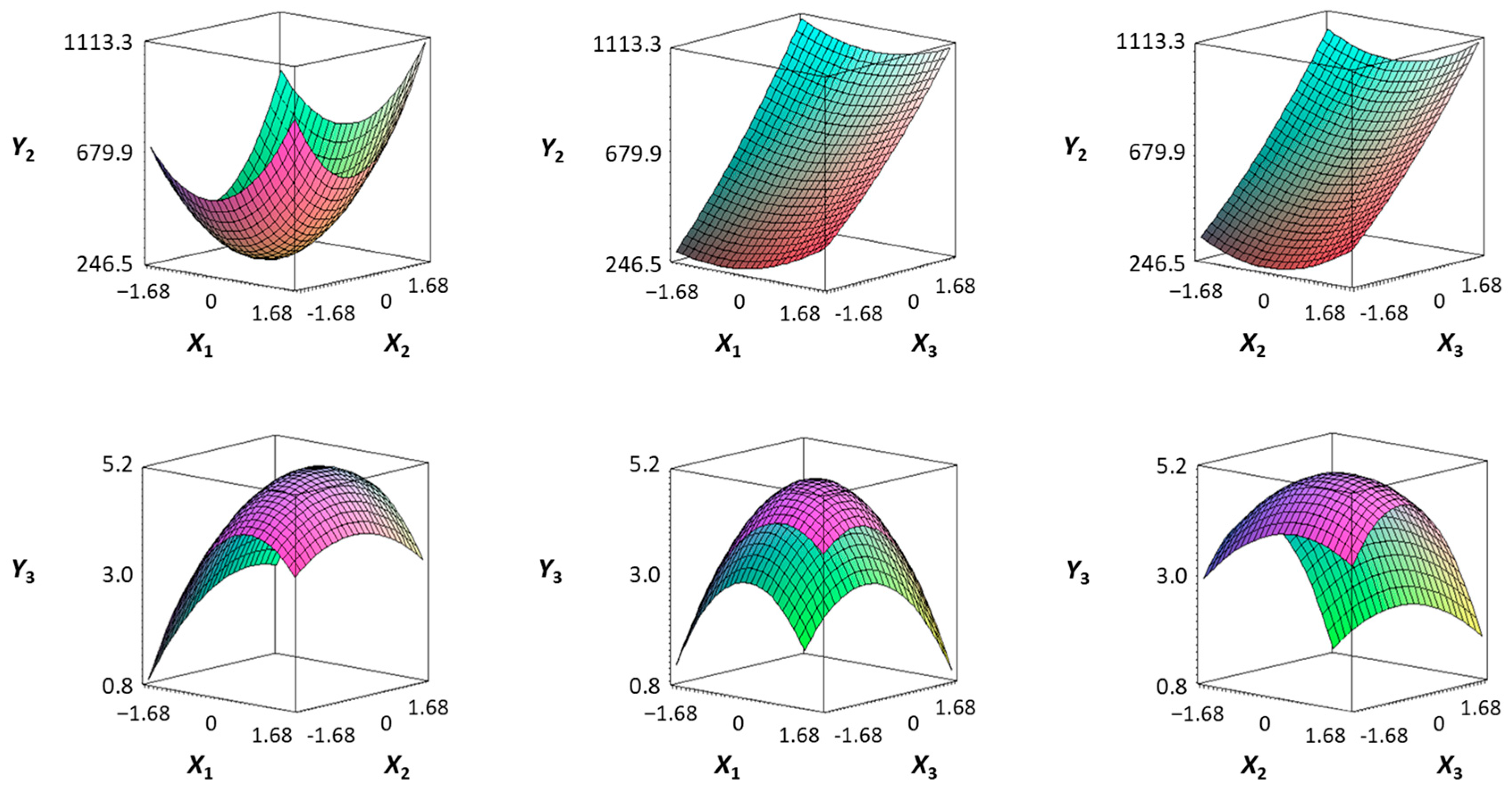

| Ingredients | Contents (g) | |
|---|---|---|
| Sous vide octopus arm | Octopus arm | 756 |
| Vinegar | 4 | |
| Shaped and boiled potato | 190 | |
| Seasoning sauce | Olive oil | 23 |
| Paprika powder | 18 | |
| Refined sugar | 7 | |
| Refined salt | 1.5 | |
| Black pepper | 0.4 | |
| Parsley | 0.1 | |
| Total | 1000 | |
| Independent Variables | Symbol | Range Level | |||||
|---|---|---|---|---|---|---|---|
| −1.682 | −1 | 0 | +1 | +1.682 | |||
| Sous vide treatment condition | Temp. (°C) | X1 | 70.0 | 76.0 | 85.0 | 94.0 | 100.0 |
| Time (min) | X2 | 69.5 | 90.0 | 120.0 | 150.0 | 170.5 | |
| Vinegar conc. (%) | X3 | 0.2 | 0.3 | 0.5 | 0.7 | 0.8 | |
| Run Number | Independent Variables | Dependent Variables | ||||||||
|---|---|---|---|---|---|---|---|---|---|---|
| Coded Values | Uncoded Values | |||||||||
| X1 | X2 | X3 | X1 | X2 | X3 | Y1 | Y2 | Y3 | ||
| Fractional factorial design (8 points) | 1 | −1 | −1 | −1 | 76.0 | 90.0 | 0.3 | 964.6 | 378.0 | 1.5 |
| 2 | +1 | −1 | −1 | 94.0 | 90.0 | 0.3 | 484.2 | 441.0 | 4.5 | |
| 3 | −1 | +1 | −1 | 76.0 | 150.0 | 0.3 | 746.9 | 406.8 | 3.0 | |
| 4 | +1 | +1 | −1 | 94.0 | 150.0 | 0.3 | 430.5 | 453.6 | 4.3 | |
| 5 | −1 | −1 | +1 | 76.0 | 90.0 | 0.7 | 971.3 | 810.0 | 1.0 | |
| 6 | +1 | −1 | +1 | 94.0 | 90.0 | 0.7 | 541.4 | 829.8 | 1.8 | |
| 7 | −1 | +1 | +1 | 76.0 | 150.0 | 0.7 | 789.2 | 838.8 | 2.0 | |
| 8 | +1 | +1 | +1 | 94.0 | 150.0 | 0.7 | 462.6 | 846.0 | 2.5 | |
| Axial portion (6 points) | 9 | −1.682 | 0 | 0 | 70.0 | 120.0 | 0.5 | 1081.8 | 594.0 | 1.2 |
| 10 | +1.682 | 0 | 0 | 100.0 | 120.0 | 0.5 | 524.8 | 646.2 | 3.5 | |
| 11 | 0 | −1.682 | 0 | 85.0 | 69.5 | 0.5 | 672.0 | 612.0 | 3.5 | |
| 12 | 0 | +1.682 | 0 | 85.0 | 170.5 | 0.5 | 454.5 | 682.0 | 4.2 | |
| 13 | 0 | 0 | −1.682 | 85.0 | 120.0 | 0.2 | 559.9 | 267.8 | 3.8 | |
| 14 | 0 | 0 | +1.682 | 85.0 | 120.0 | 0.8 | 651.4 | 919.8 | 1.0 | |
| Center points (3 points) | 15 | 0 | 0 | 0 | 85.0 | 120.0 | 0.5 | 415.2 | 561.6 | 4.8 |
| 16 | 0 | 0 | 0 | 85.0 | 120.0 | 0.5 | 395.1 | 550.8 | 4.8 | |
| 17 | 0 | 0 | 0 | 85.0 | 120.0 | 0.5 | 425.2 | 540.0 | 4.6 | |
| Parameters | Y1 | Y2 | Y3 | |||
|---|---|---|---|---|---|---|
| Coefficient | p-Value | Coefficient | p-Value | Coefficient | p-Value | |
| Constant | 411,728 | 0.000 | 550.74 | 0.000 | 4.7450 | 0.000 |
| X1 | −182,339 | 0.000 | 16.45 | 0.002 | 0.6933 | 0.000 |
| X2 | −65,759 | 0.000 | 14.95 | 0.003 | 0.3059 | 0.004 |
| X3 | 21,406 | 0.013 | 200.76 | 0.000 | −0.7841 | 0.000 |
| X1 × 1 | 138,748 | 0.000 | 24.72 | 0.000 | −0.8822 | 0.000 |
| X2X2 | 53,877 | 0.000 | 34.23 | 0.000 | −0.3519 | 0.003 |
| X3X3 | 68,875 | 0.000 | 15.42 | 0.004 | −0.8646 | 0.000 |
| X1X2 | 33,400 | 0.005 | −3.60 | 0.431 | −0.2500 | 0.032 |
| X1X3 | 5046 | 0.569 | −10.35 | 0.047 | −0.3750 | 0.005 |
| X2X3 | 1305 | 0.881 | 0.45 | 0.920 | 0.0500 | 0.609 |
| Dependent Variables | Values | Sous Vide Treatment Condition | Vinegar Soaking Condition | ||||
|---|---|---|---|---|---|---|---|
| X1 | X2 | X3 | |||||
| Y1 | Target | 400.0 |  | 400.0 | 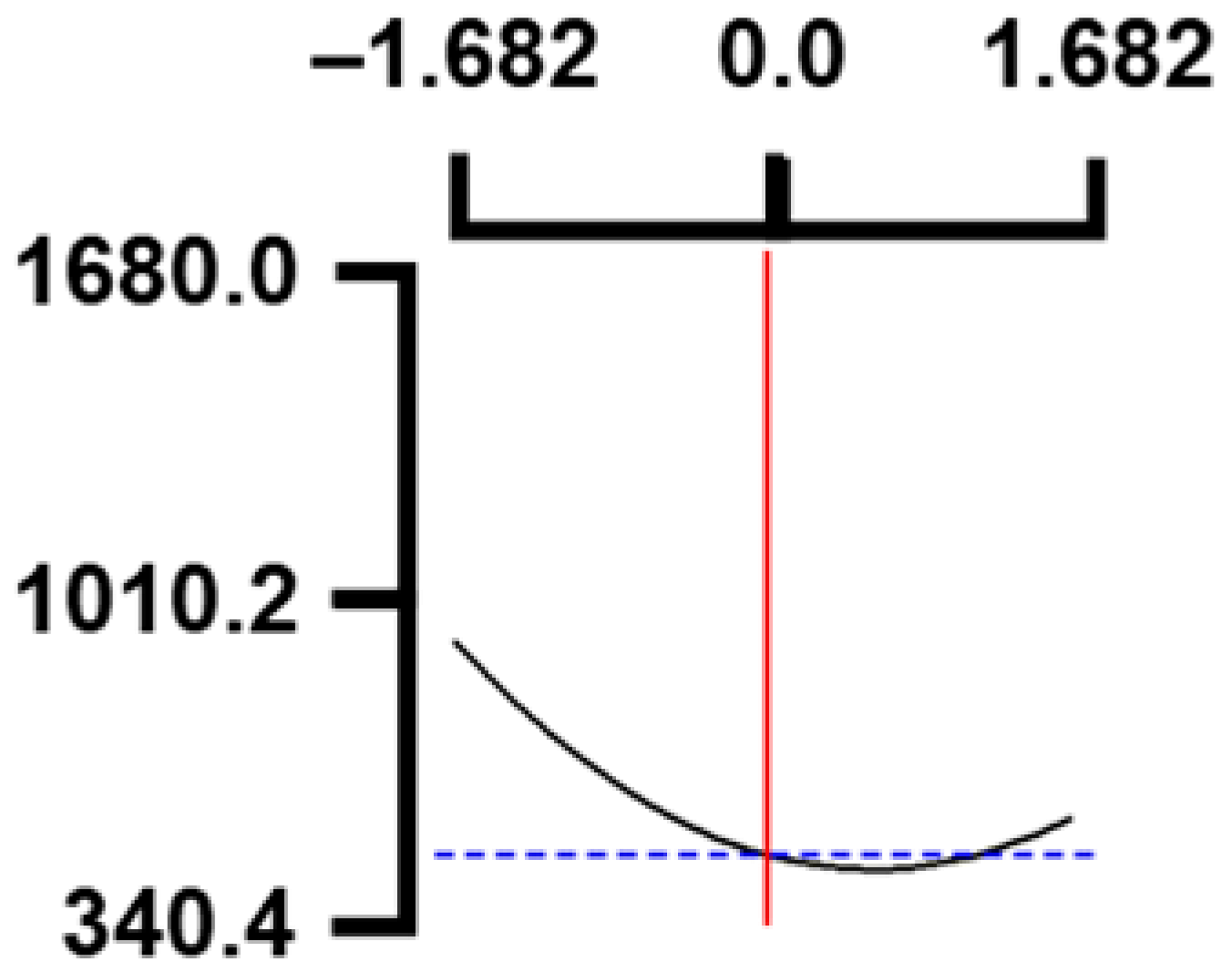 | 400.0 | 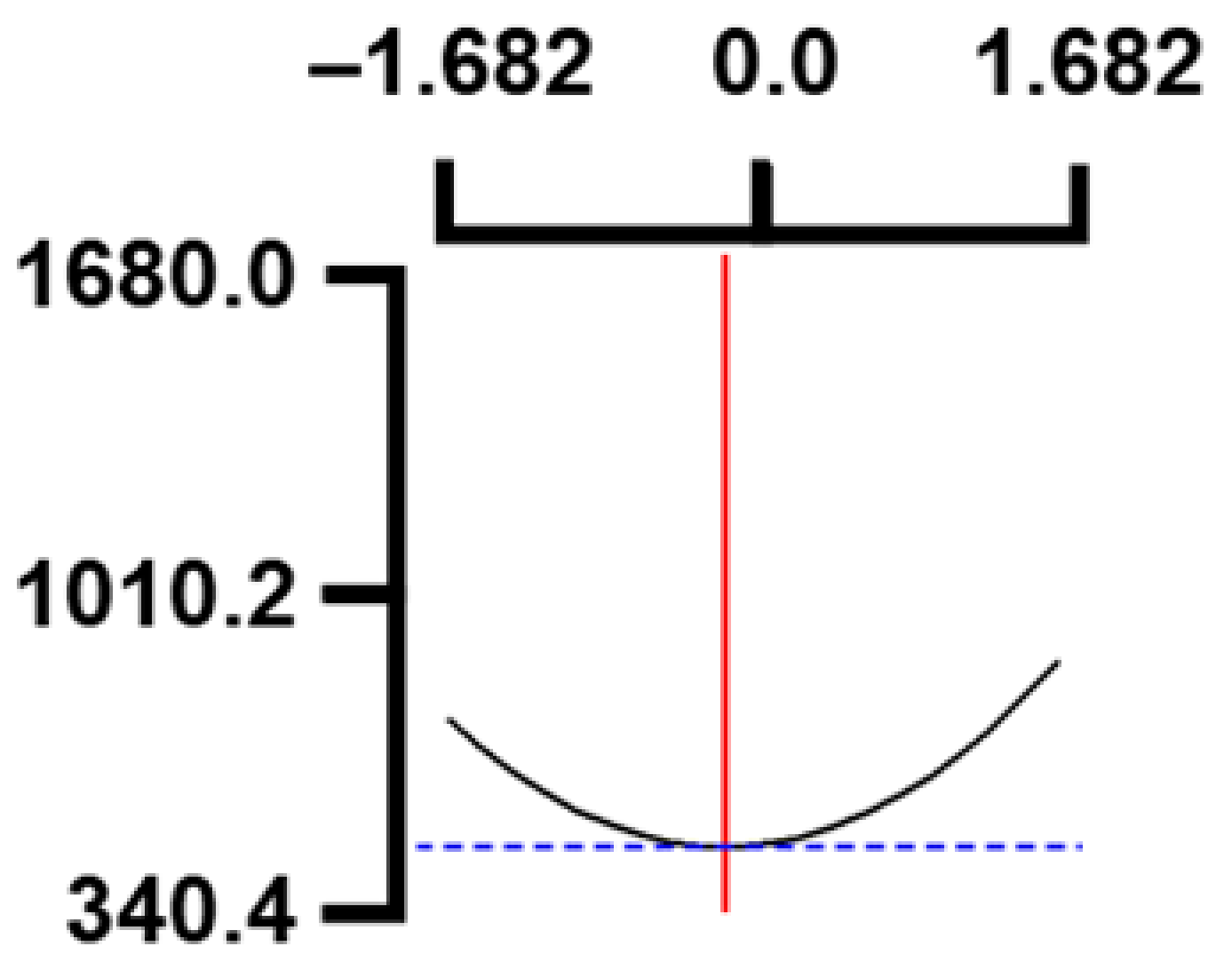 |
| Coded | 0.00 | 0.00 | −0.08 | ||||
| Actual | 85.0 | 85.0 | 0.48 | ||||
| Y2 | Target | 550.0 | 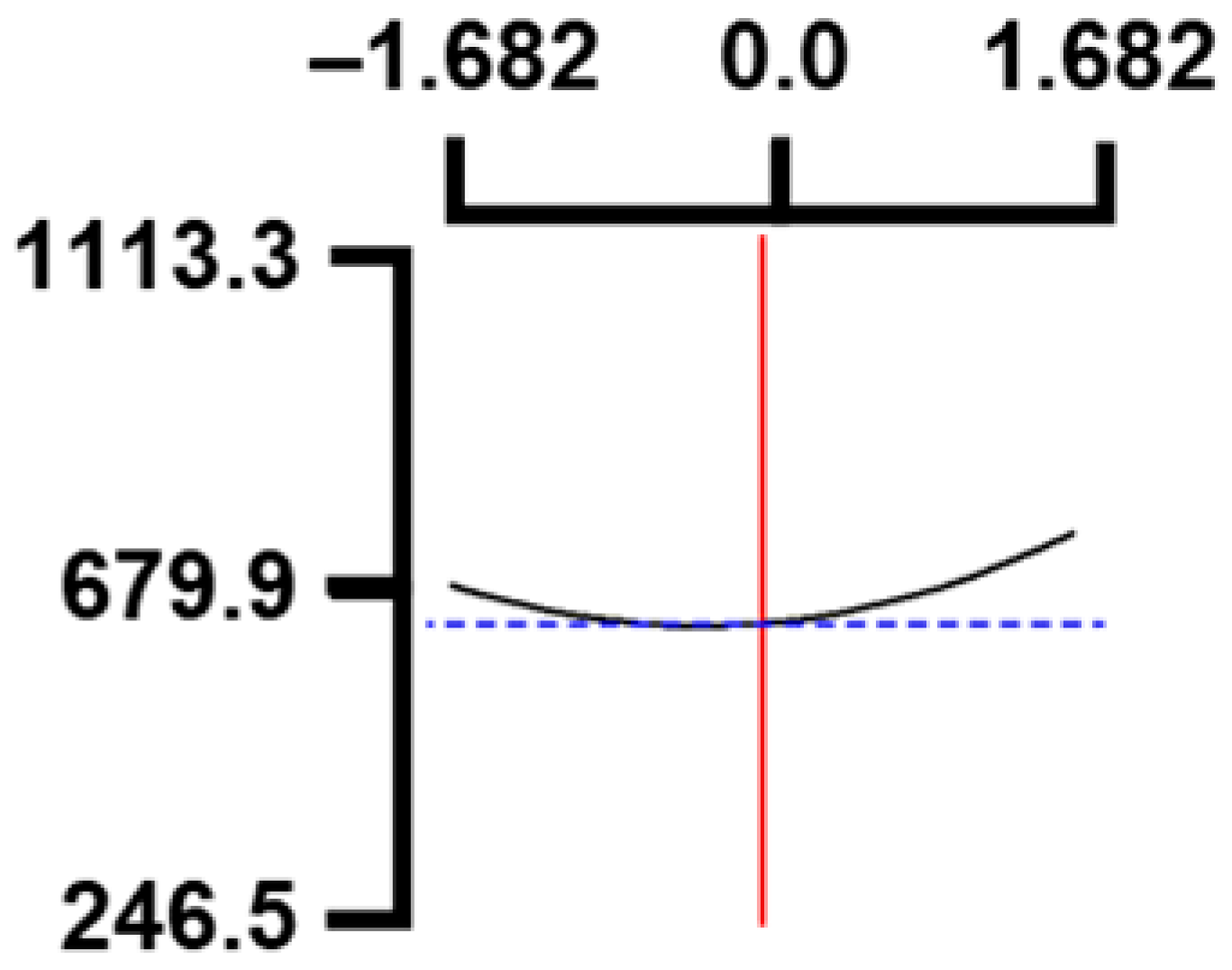 | 550.0 | 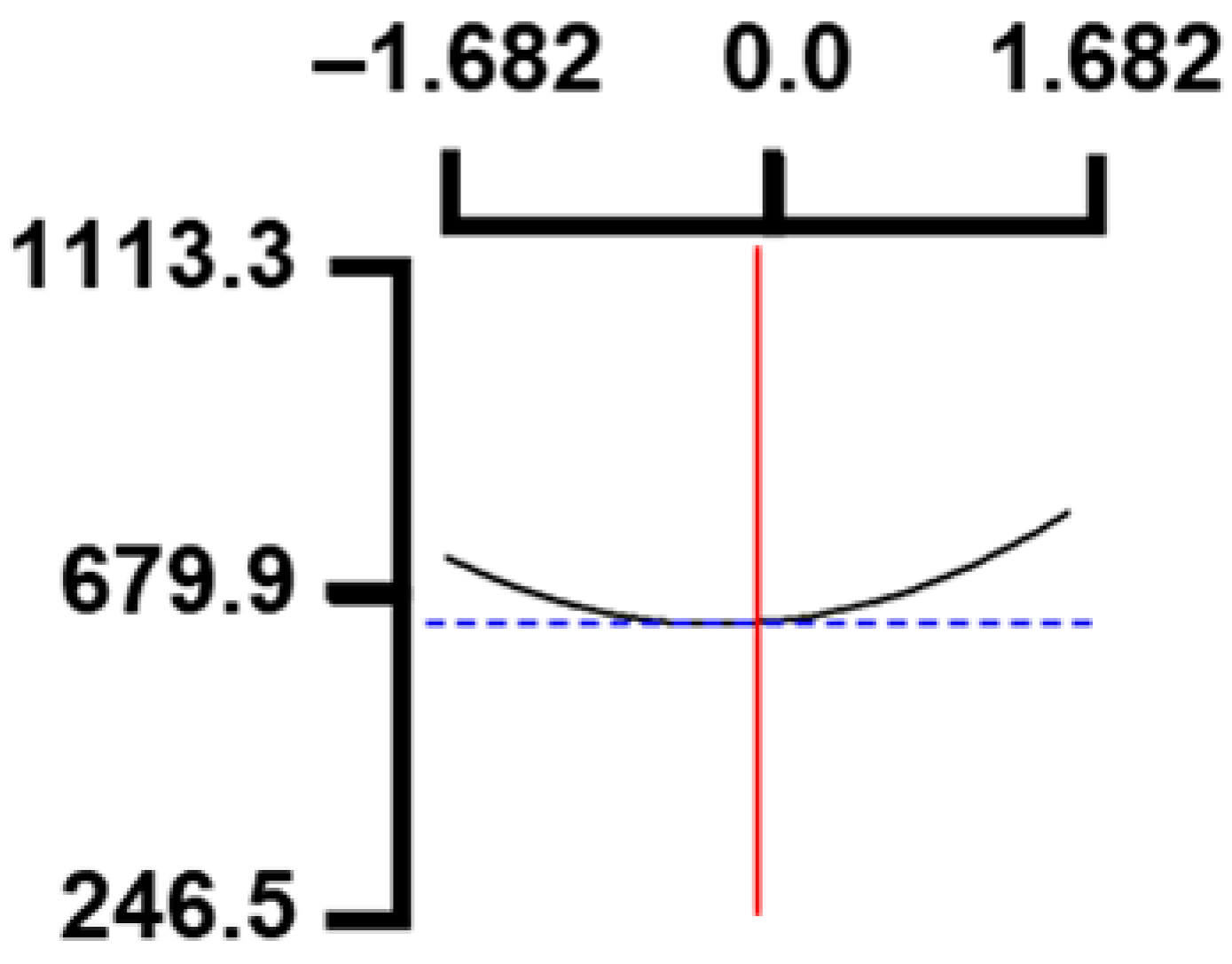 | 550.0 | 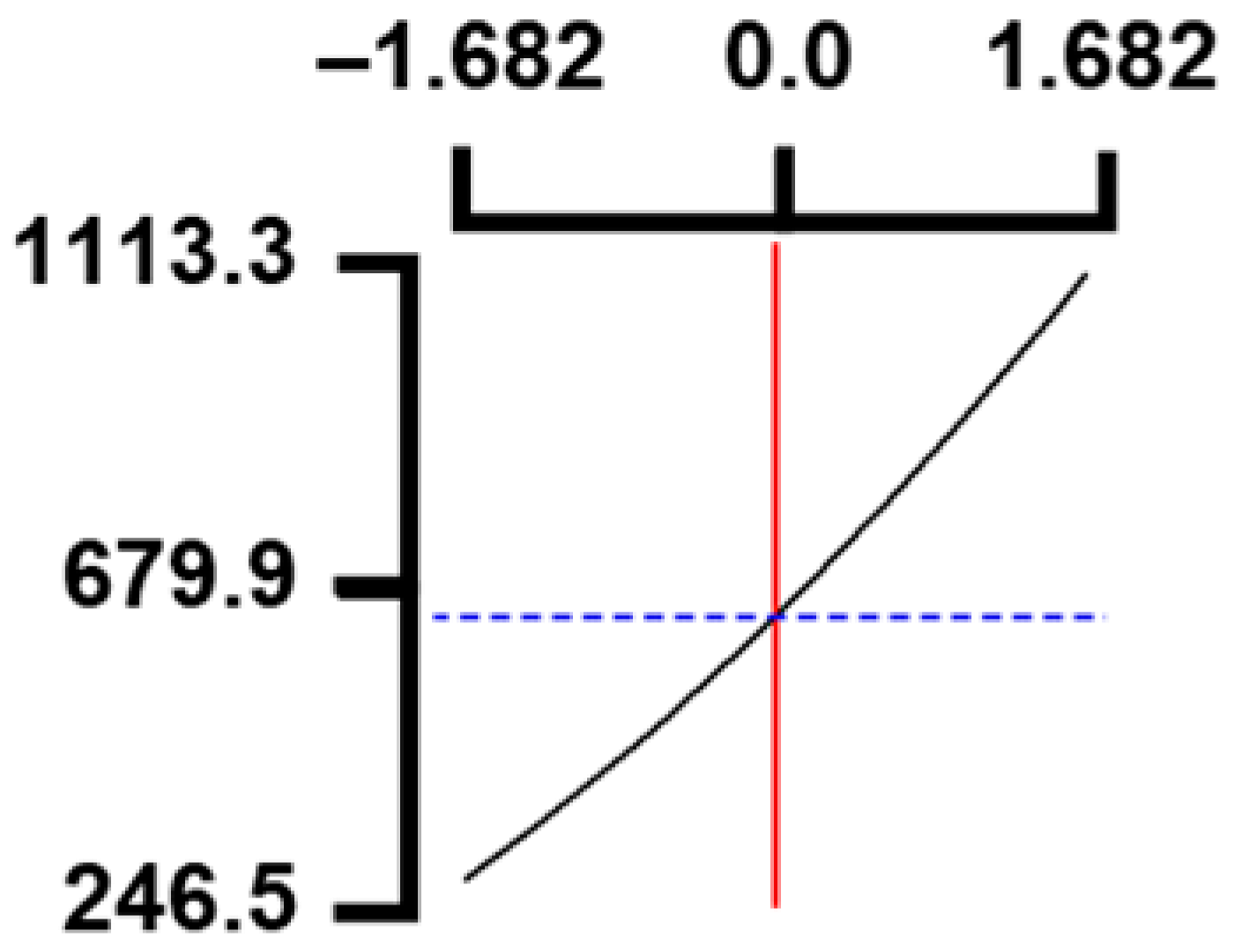 |
| Coded | 0.00 | 0.00 | 0.00 | ||||
| Actual | 85.0 | 85.0 | 0.5 | ||||
| Y3 | Target | Max. |  | Max. | 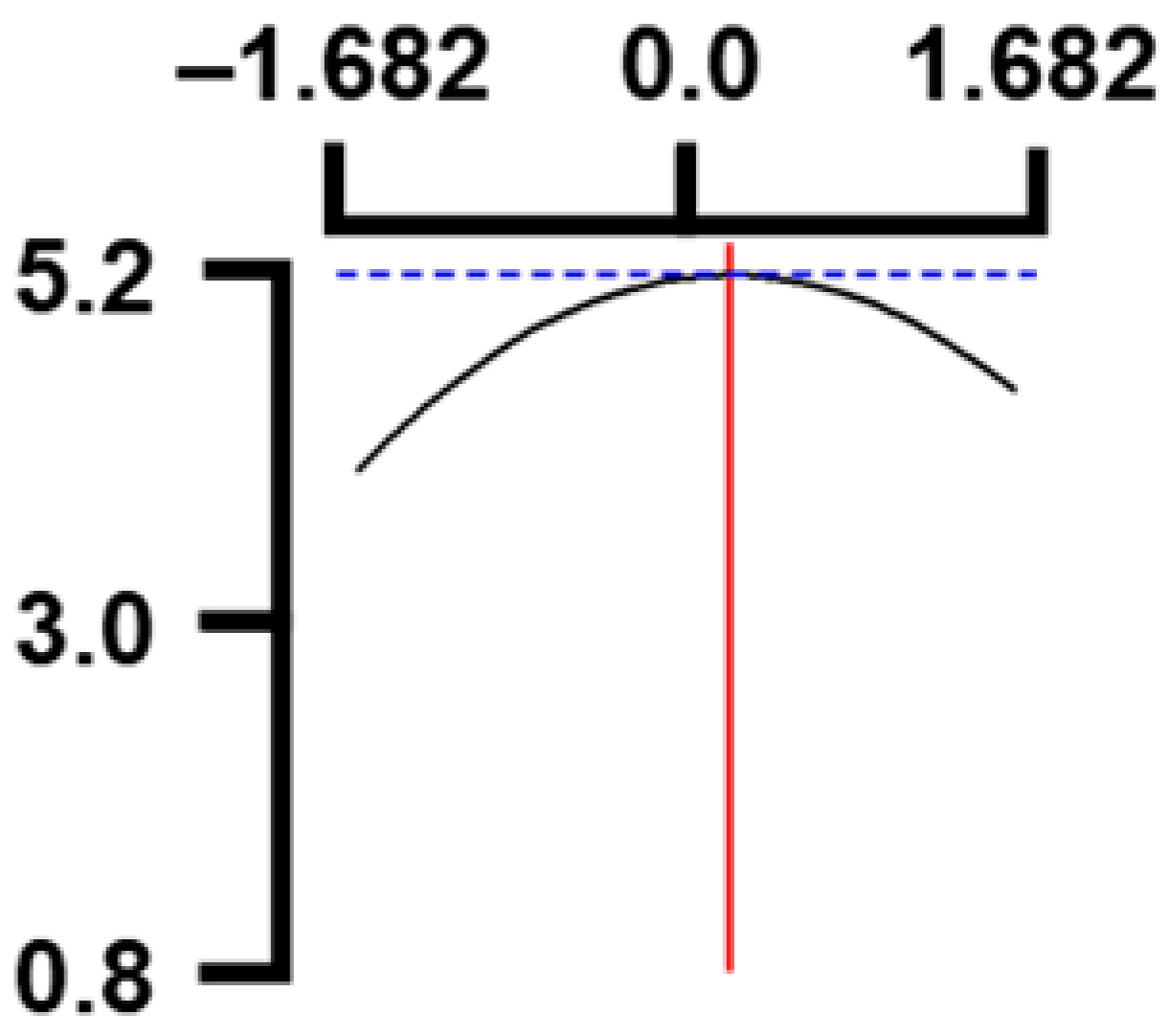 | Max. | 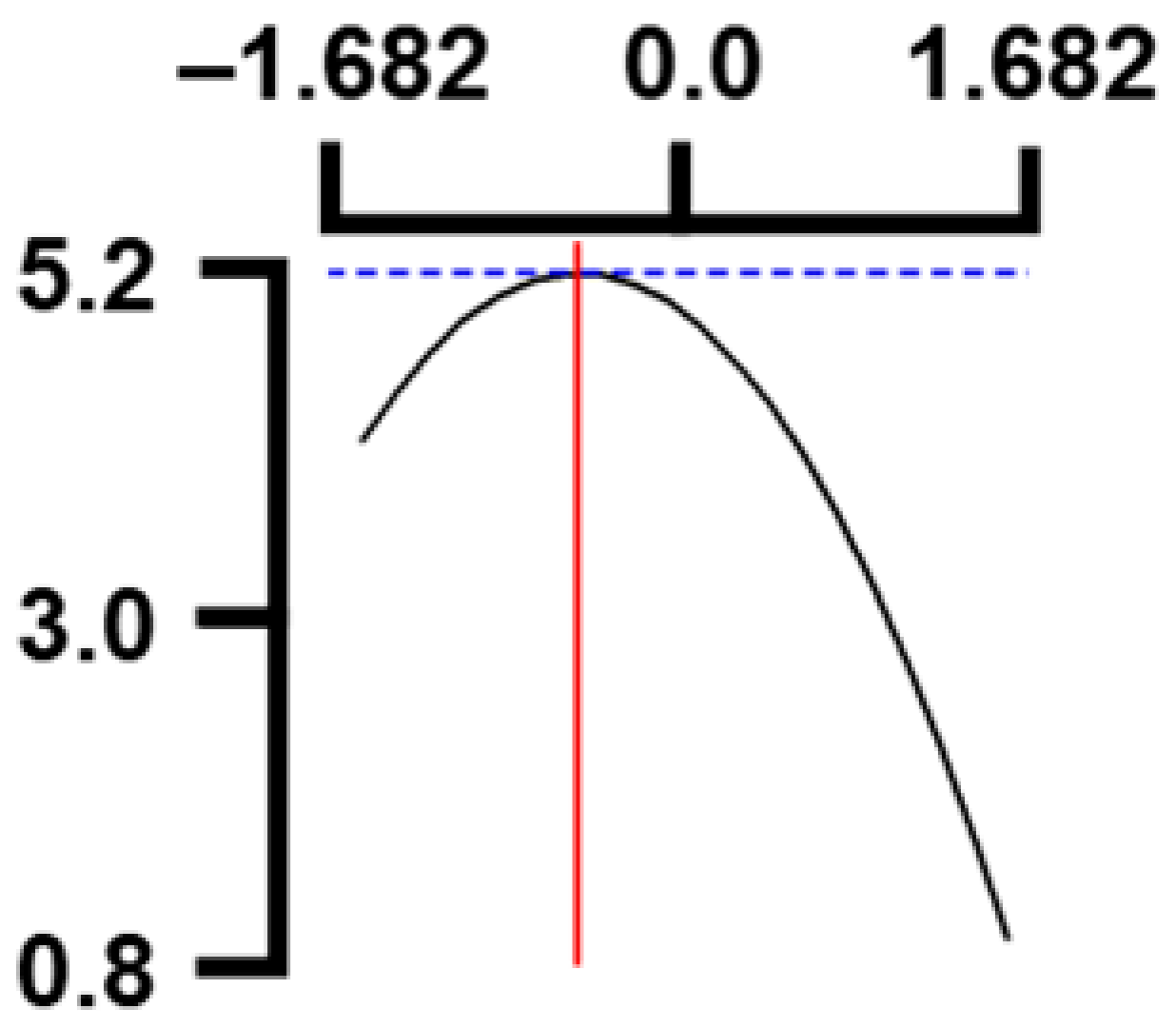 |
| Coded | 0.49 | 0.49 | −0.56 | ||||
| Actual | 89.4 | 89.4 | 0.39 | ||||
| Multiple response optimization | Coded | −0.08 | 0.66 | −0.12 | |||
| Actual | 84.3 | 139.8 | 0.48 | ||||
| Predicted | Y1: 405.0 × 1000 N/m2, Y2: 550.7 mg/100 g, Y3: 4.8 score | ||||||
| Dependent Variables | Predicted Values | Experimental Values |
|---|---|---|
| Y1 (Hardness, × 1000 N/m2) | 405.0 a | 394.5 ± 13.0 a |
| Y2 (Total acidity, mg/100 g) | 550.7 a | 551.0 ± 0.8 a |
| Y3 (Sensory texture, points) | 4.8 a | 4.9 ± 0.1 a |
| Sample | Raw | OPLGP | |
|---|---|---|---|
| Proximate composition (g/100 g) | Moisture | 82.0 ± 0.2 b | 69.6 ± 0.1 a |
| Crude protein | 15.5 ± 0.1 a | 16.9 ± 0.1 b | |
| Crude lipid | 0.6 ± 0.0 a | 7.9 ± 0.0 b | |
| Ash | 1.7 ± 0.1 a | 1.8 ± 0.0 a | |
| Carbohydrate | 0.2 | 3.8 | |
| Energy (kcal) | 72.4 | 142.4 | |
| Salinity (g/100 g) | 0.6 ± 0.0 a | 0.6 ± 0.0 a | |
| EAA | Raw | OPLGP | NEAA | Raw | OPLGP |
|---|---|---|---|---|---|
| Threonine | 706.2 (4.7) | 772.9 (4.9) | Aspartic acid | 1576.1 (10.6) | 1737.7 (11.1) |
| Valine | 686.0 (4.6) | 659.9 (4.2) | Serine | 694.1 (4.7) | 784.5 (5.0) |
| Methionine | 175.1 (1.2) | 351.5 (2.3) | Glutamic acid | 2384.3 (16.0) | 2500.8 (16.0) |
| Isoleucine | 744.6 (5.0) | 725.8 (4.6) | Proline | 677.7 (4.5) | 769.9 (4.9) |
| Leucine | 1189.7 (8.0) | 1275.5 (8.2) | Glycine | 950.3 (6.4) | 994.9 (6.4) |
| Phenylalanine | 949.3 (6.4) | 721.3 (4.6) | Alanine | 830.3 (5.6) | 866.8 (5.5) |
| Histidine | 340.9 (2.3) | 372.1 (2.4) | Cysteine | 69.0 (0.5) | 119.1 (0.8) |
| Lysine | 1196.6 (8.1) | 1221.5 (7.8) | Tyrosine | 411.9 (2.8) | 533.4 (3.4) |
| Arginine | 1275.4 (8.6) | 1224.8 (7.8) | Sub-total | 7593.7 (51.1) | 8307.1 (53.1) |
| Tryptophan | - | - | Total | 14,857.5 (100.0) | 15,632.4 (99.9) |
| Sub-total | 7263.8 (48.9) | 7325.3 (46.8) |
| Mineral Contents | Raw | OPLGP |
|---|---|---|
| Calcium (Ca) | 26.2 ± 0.2 b | 21.7 ± 0.3 a |
| Potassium (K) | 305.0 ± 3.1 b | 170.6 ± 4.0 a |
| Iron (Fe) | 3.5 ± 0.0 a | 5.7 ± 0.0 b |
| Zinc (Zn) | 0.8 ± 0.0 b | 0.4 ± 0.0 a |
| FA | Raw | OPLGP | FA | Raw | OPLGP | FA | Raw | OPLGP |
|---|---|---|---|---|---|---|---|---|
| C12:0 | ND | ND | C14:1 | 0.1 (0.0) | ND | C20:3n-6 | 0.2 (0.1) | 2.0 (0.0) |
| C14:0 | 3.6 (1.3) | 13.0 (0.2) | C16:1 | 5.8 (2.0) | 68.4 (1.1) | C20:3n-3 | 1.0 (0.4) | 6.3 (0.1) |
| C15:0 | 0.6 (0.2) | 3.8 (0.1) | C18:1n-9 | 31.1 (10.7) | 3822.6 (60.6) | C22:2NMID | 0.5 (0.2) | 6.9 (0.1) |
| C16:0 | 48.2 (16.7) | 856.8 (13.6) | C20:1n-9 | 12.8 (4.4) | 38.9 (0.6) | C20:5n-3 | 54.2 (18.7) | 150.2 (2.4) |
| C17:0 | 4.8 (1.7) | 23.2 (0.4) | C22:1n-9 | 0.9 (0.3) | 18.9 (0.3) | C22:6n-3 | 79.7 (27.5) | 227.4 (3.6) |
| C18:0 | 19.5 (6.7) | 245.9 (3.9) | C24:1n-9 | 0.3 (0.1) | ND | ƩPUFA | 144.6 (50.0) | 1111.5 (17.6) |
| C20:0 | 0.2 (0.1) | 28.1 (0.4) | ƩMUFA | 51.0 (17.5) | 3948.8 (62.6) | Ʃω-6 | 7.2 (2.5) | 667.1 (10.6) |
| C23:0 | 16.7 (5.8) | 57.4 (0.9) | C18:2n-6 | 7.0 (2.4) | 665.1 (10.5) | Ʃω-3 | 135.7 (46.9) | 437.5 (6.9) |
| C24:0 | 0.2 (0.1) | 16.6 (0.3) | C18:3n-3 | 0.8 (0.3) | 53.6 (0.9) | Total FA | 289.4 (100.1) | 6305.1 (99.9) |
| ƩSFA | 93.8 (32.6) | 1244.8 (19.7) | C20:2NMID | 1.2 (0.4) | ND | Total Lipid | 600 (48.2) | 7900 (79.8) |
| Sample | Raw | OPLGP | |
|---|---|---|---|
| Freshness indicators | pH | 6.70 ± 0.0 a | 6.92 ± 0.0 b |
| VBN (mg/100 g) | 6.5 ± 1.6 a | 14.8 ± 0.8 b | |
| TBC (CFU/g) | 2.0 × 10 b | 1.2 × 10 a | |
| Heavy metal | Pb (mg/kg) | 0.06 ± 0.00 b | 0.01 ± 0.00 a |
| Cd (mg/kg) | 0.09 ± 0.00 b | 0.02 ± 0.00 a | |
| Acceptability Evaluation | A (Raw) | B (Boiled) | C (Sous Vide) | D (Vinegar/ Sous Vide) |
|---|---|---|---|---|
| Appearance | 6.8 ± 0.9 a | 7.1 ± 0.9 a | 7.4 ± 0.7 a | 7.8 ± 0.6 a |
| Taste | 6.1 ± 0.6 a | 7.5 ± 0.7 b | 7.7 ± 0.5 b | 8.2 ± 0.6 b |
| Flavor | 5.3 ± 0.7 a | 7.3 ± 1.0 b | 7.2 ± 0.6 b | 7.8 ± 0.7 b |
| Texture | 4.3 ± 0.7 a | 6.3 ± 0.9 b | 7.4 ± 0.9 b | 8.4 ± 0.9 b |
| Overall acceptance | 5.6 ± 0.3 a | 7.0 ± 0.5 b | 7.4 ± 0.4 b | 8.0 ± 0.4 b |
Disclaimer/Publisher’s Note: The statements, opinions and data contained in all publications are solely those of the individual author(s) and contributor(s) and not of MDPI and/or the editor(s). MDPI and/or the editor(s) disclaim responsibility for any injury to people or property resulting from any ideas, methods, instructions or products referred to in the content. |
© 2023 by the authors. Licensee MDPI, Basel, Switzerland. This article is an open access article distributed under the terms and conditions of the Creative Commons Attribution (CC BY) license (https://creativecommons.org/licenses/by/4.0/).
Share and Cite
Kang, S.-I.; Kim, J.-S.; Park, S.-Y.; Lee, S.-M.; Jang, M.-S.; Oh, J.-Y.; Choi, J.-S. Development and Quality Characteristics of Elderly-Friendly Pulpo a La Gallega Prepared Using Texture-Modified Octopus (Octopus vulgaris) Arms. Foods 2023, 12, 3343. https://doi.org/10.3390/foods12183343
Kang S-I, Kim J-S, Park S-Y, Lee S-M, Jang M-S, Oh J-Y, Choi J-S. Development and Quality Characteristics of Elderly-Friendly Pulpo a La Gallega Prepared Using Texture-Modified Octopus (Octopus vulgaris) Arms. Foods. 2023; 12(18):3343. https://doi.org/10.3390/foods12183343
Chicago/Turabian StyleKang, Sang-In, Jin-Soo Kim, Sun-Young Park, Seok-Min Lee, Mi-Soon Jang, Jae-Young Oh, and Jae-Suk Choi. 2023. "Development and Quality Characteristics of Elderly-Friendly Pulpo a La Gallega Prepared Using Texture-Modified Octopus (Octopus vulgaris) Arms" Foods 12, no. 18: 3343. https://doi.org/10.3390/foods12183343
APA StyleKang, S.-I., Kim, J.-S., Park, S.-Y., Lee, S.-M., Jang, M.-S., Oh, J.-Y., & Choi, J.-S. (2023). Development and Quality Characteristics of Elderly-Friendly Pulpo a La Gallega Prepared Using Texture-Modified Octopus (Octopus vulgaris) Arms. Foods, 12(18), 3343. https://doi.org/10.3390/foods12183343







